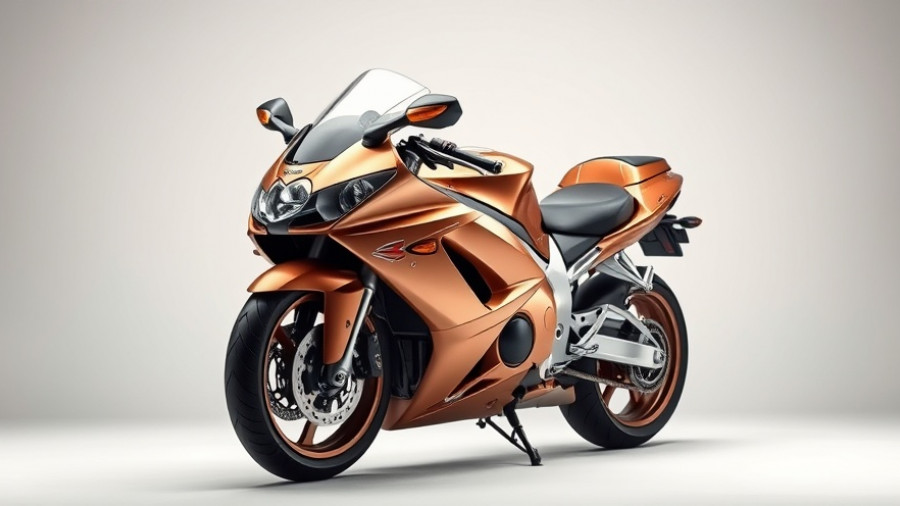
Unpacking the Legacy of the 1999 Suzuki Hayabusa
In the intense competition of the motorcycle world during the 1990s, speed became an obsession for major Japanese manufacturers. With the stage set, Suzuki launched the Hayabusa (GSX1300R) in 1999, which would ultimately rewrite the speed records and define a new genre of motorcycles. Nestled within the ongoing battle for speed supremacy, the Hayabusa quickly ascended to iconic status, often cited as an unforgettable piece of motorcycling history.
The Birth of a Speed Icon
When the Hayabusa first burst onto the scene, it boasted a staggering top speed of 194 mph (or 312 km/h - unrestricted), an achievement that captivated the imagination of motorcycle enthusiasts globally. This eclipsed Honda's Blackbird by just a single mph, immediately sparking excitement and rivalry. Named after the peregrine falcon, known for its incredible speed, the bike not only symbolized speed but also brought with it Suzuki's ambition to define what power and performance could mean for a production motorcycle.
A Look Under the Hood: What Makes the Hayabusa Special?
The heart of the Hayabusa is a formidable inline-four engine. With a displacement of 1298cc and generating 173 horsepower, it became the most powerful production motorcycle right out of the gate. This engineering marvel was not merely about raw speed; it exhibited finesse and control, facilitating a smoother ride. However, enthusiasts argue that the titanic power it produced was paired with a chassis that lacked modern technology, drawing mixed perceptions from critics and riders alike.
Design and Aerodynamics: Love It or Hate It?
The Hayabusa’s design is nothing short of polarizing. Many called it a technological masterpiece while other viewers felt bewildered by its aesthetic appeal. Its bulbous and unconventional body shape optimized aerodynamics; however, such radical design choices resulted in mixed opinions. As history shows, effective performance often trumps traditional styling, and the Hayabusa’s legacy have been amplified by its ability to transcend typical motorcycle designs.
How the Hayabusa Reshaped the Motorcycle Industry
The Hayabusa didn't just excel in raw speed; it played a pivotal role in game-changing the future of motorcycling. Once it hit the market, subsequent manufacturers entered a gentlemen's agreement, capping speeds at 186 mph to avoid governmental scrutiny into high-speed motorcycles. This shift from outright speed races to engineering advancements in handling, braking, and technology led to thrilling innovations. It made way for segmenting hyperbikes and sport-tourers, appealing to not only speed demons but also those who longed for the thrill of high-speed convenience.
The Cult Following and Pop Culture Impact
Throughout its history, the Hayabusa has accumulated a dedicated fan base represented through clubs and events around the world. This motorcycle has seeped into pop culture, making appearances in popular films and video games, cementing its status as a symbol of performance and freedom on two wheels. The fascination with the Busa transcends mere hobby; it represents a lifestyle and sense of belonging to a vibrant community.
Model Evolution: From Gen 1 to Gen 3
Over a quarter of a century, the Suzuki Hayabusa has seen notable transformations while still retaining its core identity. Each subsequent generation introduced refinements — turning it from a raw powerhouse into a longer-lasting machine with updated technology. Innovations such as cornering ABS and lean-sensitive traction control have transformed the riding experience, bringing the Busa up to par with contemporary motorcycles while maintaining the spirit of its predecessor.
Final Thoughts: Why the Hayabusa Remains Unforgettable
The Suzuki Hayabusa is more than just machinery; it embodies an era of motorcycle history. From cinematic fame to igniting fierce competitions among manufacturers, it has proven to be a lasting legacy of design, performance, and community in the world of motorcycles. Even as the automotive industry pivots to new innovations in electric vehicles and hybrid efficiencies, the essence of the Hayabusa remains an essential chapter in motorcycle lore.
So whether you love it as a speedster or view it critically through the lens of design, one conclusion is undeniable — the Suzuki Hayabusa holds a transformative place in motorcycling history. This is not just a bike; it’s a testament to the pursuit of distance, speed, and the thrill of riding. As the auto industry evolves, the Hayabusa remains a landmark of ambition and engineering prowess that won’t be forgotten.
 Add Row
Add Row  Add
Add 




Write A Comment